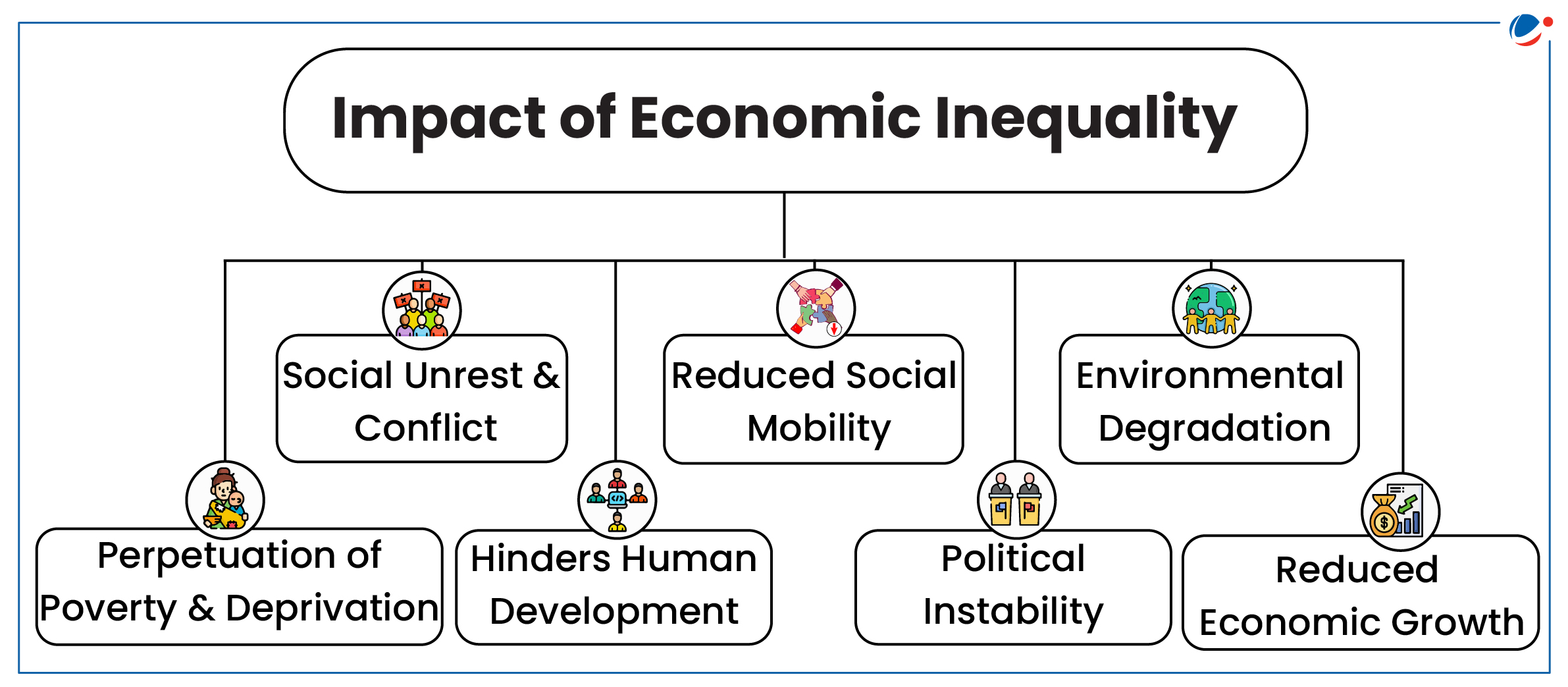Why in the news?
Several reports have underscored high income and wealth inequality in India, triggering a debate on economic inequality, concentration and distribution of wealth.
About Economic Inequality in India
- Wealth Inequality: India is one of the most unequal countries. Rich are getting richer at a much faster pace while the poor are still struggling to earn a minimum wage (Oxfam report).
- Income Inequality: 22.6% of the national income went to the top 1% (World Inequality database, 2022-23). It is among the very highest in the world, higher than even the US.
- Rural-Urban Divide: Average Monthly Per Capita Consumption Expenditure is Rs. 3,773 in rural and Rs. 6,459 in urban India (Household Consumption Expenditure Survey 2022-23).
- Gender Pay Gap: In India, men earn 82 % of the labour income, whereas women earn 18 % of it (World Inequality Report 2022).
Key findings of the Oxfam Report
|
Reasons for Rising Economic Inequality
- Uneven Economic Growth: Benefits of economic growth have been unevenly distributed, with the certain states, and certain sectors benefiting disproportionately.
- E.g., Service sector which contributes about 60% of the GDP is mainly concentrated in Maharashtra, Karnataka etc.
- COVID-19 Pandemic: COVID-19 has led to the diminishing of wealth for the bottom 50% of the Indian population.
- Total number of billionaires in India increased from 102 in 2020 to 166 billionaires in 2022, while the number of hungry Indians has increased from 19 crores to 35 crores.
- Tax System: Government reduced corporate tax slabs from 30% to 22%, while excise duties and GST on goods and services were substantially increased.
- Approximately 64% of the total GST in the country came from the bottom 50% of the population, while only 4% came from the top 10%.
- Lack of Quality Education and Healthcare: It perpetuates intergenerational poverty and limits economic mobility, especially in rural areas and among marginalized communities.
- Lack of education, have trapped some people in low-paid jobs and depressed the growth of the bottom 50 % and middle 40 % of Indians (world Inequality lab).
- Liberalization, Privatization and Globalization (LPG): Telecom and civil aviation benefitted the most from LPG reforms while agriculture and small-scale industries remained neglected.
- Large proportion of India's workforce employed agriculture and small-scale industries, often receives low wages, lack of social security etc.

Measures Undertaken to Reduce Economic Inequality
- Inclusive Growth: Deendayal Antyodaya Yojana-National Rural Livelihood Mission aims to reduce poverty by enabling poor households to access gainful self-employment and skilled wage employment opportunities.
- Other initiatives: Mahatma Gandhi National Rural Employment Guarantee Yojana, Pradhan Mantri Awas Yojana, Skill India Mission etc.
- Financial Inclusion: Pradhan Mantri Jan-Dhan Yojana to ensure access to financial services, namely, Banking/ Savings, insurance, remittance etc.
- Other Initiatives: Pradhan Mantri Mudra Yojana, Stand-Up India Scheme etc.
- Social security Measures: Atal Pension Yojana is an old age income security scheme for unorganized sector in the age group of 18-40 years.
- Other Initiatives: Pradhan Mantri Suraksha Bima Yojana (Accident Insurance), Pradhan Mantri Jeevan Jyoti Yojana etc.
- Promoting Gender Equality: Beti Bachao Beti Padhao Scheme launched to prevent gender biased sex selective elimination, ensure education and participation of the girl child etc.
- Other Initiatives: One Stop Centre Scheme, SWADHAR Greh, Pradhan Mantri Matru Vandana Yojana etc.
- Sustainable Development: National Mission for Sustainable Agriculture launched to make agriculture more productive, sustainable, and remunerative and climate resilient.
- Other initiatives: National Mission on Enhanced Energy Efficiency, National Action Plan on Climate Change etc.
Challenges in Countering the Wealth and Income Inequality
- Size and Diversity of the Population: India's massive and diverse population of over 1.3 billion makes it challenging to implement uniform policies and initiatives effectively.
- Persistent Social Inequalities: Based on caste, gender, and other factors continue to perpetuate economic disparities, hindering the impact of policies aimed at reducing inequality.
- Limited Resources: India's limited financial resources often constrain the government's ability to allocate sufficient funds for comprehensive programs targeting economic inequality.
- Governance and Implementation Challenges: Inefficient governance, corruption, and poor implementation of policies and programs.
- Resistance to Structural Reforms: Vested interests and resistance to structural reforms, such as land reforms, labor reforms, and progressive taxation.
Way Forward
- Inclusive Economic Growth: Promote policies that create job opportunities and support entrepreneurship, especially in rural areas and for marginalized communities.
- Investing in rural infrastructure and development to bridge the urban-rural divide.
- Access to Education and Healthcare: Enhancing budgetary allocation of the health sector, ensuring quality education etc. is crucial for breaking the cycle of poverty and inequality.
- Strengthening Social Security Measures: Cash transfers, subsidies, and pension schemes, to provide a safety net for the economically disadvantaged.
- Taxing India's Wealthiest: Taxing even 1% is enough to fund major government schemes. Additionally, easing the tax burden on the poor could reduce economic inequality.
- Addressing Social and Cultural Barriers that perpetuate inequality, such as caste-based discrimination and gender disparities.



